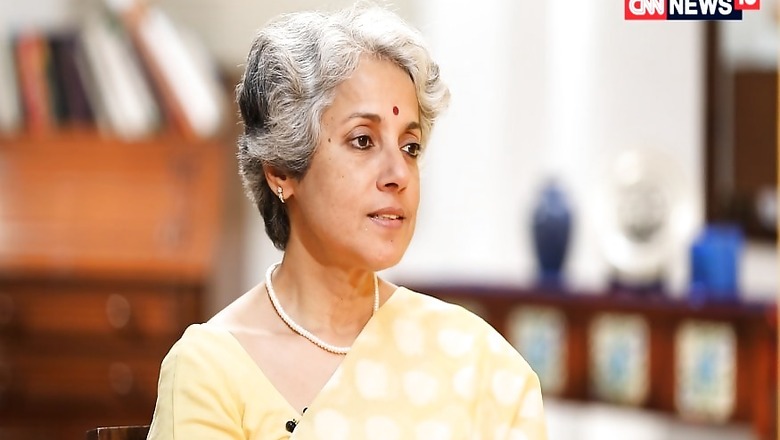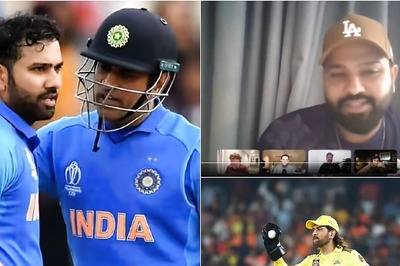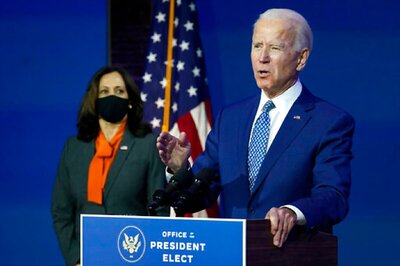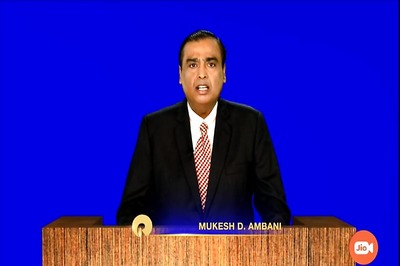
views
Dr. Soumya Swaminathan, Chief Scientist at the World Health Organization, is optimistic that the world will have a vaccine for Covid-19 by early next year, but warns against healthcare resource allocation to the pandemic at the exclusion of other diseases. In an interview to News18, Swaminathan says that the response to lockdown measures by various countries has been varied, depending on how thoroughly governments were able to implement physical distancing and other norms.
Edited excerpts:
How do you assess India’s interventions such as the national lockdown to combat the spread of the coronavirus, considering that metros like Delhi and Chennai have been severely affected?
This is an issue that all countries have been grappling with. As you know, the WHO had advised what we call public health and social measures, which countries needed to take. And every country adapted it and adopted it as per their needs, and the state of the epidemic that they found themselves in.
The term lockdown has come about after many countries instituted very strict measures, which basically tried to prevent all physical contact between people, and thereby reduce the spread of the infection. I think what is clear is that there has been a difference in the response to the lockdown in different settings. We have seen in some of the European countries that implemented the lockdown when cases were really going up. It did have an impact in reducing the number of new infections. It managed to cut transmissions. It brought the curve down and now lockdowns are lifted in these countries gradually in workplaces and schools and things are slowly reopening.
There needs to be a continued emphasis on isolation, inspection of the active cases, their contacts, and a very active contact-tracing to maintain low levels of infection. In other countries that implemented lockdown, and these are mostly countries which are heavily populated like India which are in the urban settings, lockdown has not had the same impact as it had in other countries, and possibly this is because there is difficulty in implementing physical distancing in a heavily dense environment.
Therefore, the strategy there has to be different. The strategy has to be tailored to the local context. It has to be different in rural and urban areas. The focus really needs to be on detection of active infections, on the tracking, on the quarantining. As lockdowns are ending, the ramping up of testing cannot be overemphasised.
The entire strategy is now going to depend on making sure that the local authorities have a complete overview of where the infection is, that they are able to contain it. We have seen places where there have been no cases for many weeks and suddenly there are clusters that come up. The fact is that the majority of the population across the world is susceptible to the virus.
And therefore, any introduction, even if you're able to clear the infection, any introduction of the virus, will result in further clusters. So focus has to be on trying to contain those clusters as much as possible by extending testing, tracking and the isolation and quarantine. Basic public health measures need to be strengthened till the time that a vaccine is available to inoculate people in large numbers.
Experts say the peak is yet to come for India. We understand that the Americas and South Asia are hotspots for the virus. Given how countries have responded, how do you think it will play out in India?
It all depends on what the response is. And it's not only the virus’s behaviour, it's also the behaviour of people and governments which determines what happens. Even in countries that have gone past the first peak, they are seeing another peak happening. It could be a smaller peak, but nevertheless, it’s another peak, which happens when you relax the stringent measures.
In some countries, it is possible that the plateau continues for a much longer period without a dramatic decline in the peak. And, it is also possible that you go through a period of ups and downs for several months.
In the northern hemisphere, they’re expecting that it may go to a lower level of transmission and then, it may go up around the beginning of the winter season, which is when you have the influenza and other respiratory viruses peaking. So, it is very hard right now to predict when there’ll be a peak.
Right now, the situation in India as well as the neighbouring countries in south Asia is that the cases are on the rise. Therefore, all measures have to be made to contain the increase in new cases.
Dexamethasone has shown promise in cases of seriously ill Covid-19 patients. How much hope do you have in this drug, given the stand that randomised trials are the only evidence for such drugs>
Dexamethasone is a very old drug, and it has been used by physicians for a very long time to treat inflammatory conditions in many different kinds of illnesses. It is used in intensive care.
Now, there has always been controversy about the impact of Dexamethasone in acute respiratory distress syndrome (ARDS, a common cause of death in seriously ill Covid-19 patients), and many studies have shown that it is not really effective. And this is a viral infection, remember.
In a viral infection, steroids could have negative effects as well as beneficial effects. So, what the Recovery Trials (UK’s research effort for a vaccine) have shown is that when Dexamethasone was administered to hospitalised patients -- some of them quite serious; around two-thirds either received oxygen or were on ventilation -- it reduced the death rate of the most critically ill (receiving ventilation) and also those moderately ill (receiving oxygen).
It did not have not an impact on those needing neither oxygen nor ventilation. So, what it shows is that at the stage when there is an inflammatory response of the body, damaging the lungs, steroids did have an impact.
Dexamethasone did have an impact: a one-third reduction in mortality. But it is really important that people do not use Dexamethasone at all stages of the disease. It showed very clearly which group it benefits.
I think that’s the power of randomised trials. Even though people may have known about this drug, it conclusively showed what the benefit of this drug is, which group it benefits and where it does not have benefits.
And there are drugs under trial, like the Solidarity Trials of the WHO, and the Recovery Trials, and the NIH (National Institute of Health) in the US and many other centres around the world. What we aim to do is pool all of that data from ongoing trials, look at the evidence on Hydroxychloroquine, Dexamethasone, drugs like Lopinavir-Ritonavir and Remdesivir, so that we are able to make recommendations and guidelines for doctors.
We understand that various trials are underway to develop a vaccine for coronavirus. In your estimate, when can we expect a vaccine available for public use?
This question is very difficult to answer because there are many steps and many things that happen on the way in vaccine development. The normal, or minimum, time-frame is about five years, but here, the world has decided that we need a vaccine as soon as possible; if possible even less than 12 months.
So, currently there are 12 vaccines globally that have entered human trials from Phase I to Phase II. Most of them are in Phase I and II and there are two or three which may be entering clinical trials in July or August. So, by the end of the year, we hope that we have results from these 12.
The first thing is to find out if any of these are actually effective in reducing transmission and whether they are safe enough for use. Both of these are very important, and then manufacturers have to ramp up to produce not just millions, but the billions of doses that are going to be needed.
I feel optimistic because there is huge investment in research and development across the world. At least 220 candidates at some stage of development. Secondly, many different kinds of vaccine platforms are being tested like DNA and RNA vaccines, which have never been used in humans.
There is a chance that one of more of these will be successful. But what we still don’t understand is the immunity against this virus. How long does antibody immunity last? All these can only be found out through well-conducted studies and I know that India is planning a large number of these studies to add to the global knowledge. I would say that in an optimistic scenario, by early 2021, we should have some vaccine available for use for at least most vulnerable groups.
This is where WHO is now working with our member states to discuss a fair allocation framework. It's really important that a vaccine developed should not be available only to those who can afford to pay for it or be restricted to some countries. It should be available to people around the world and there needs to be an agreed upon way of distributing the available resources.
It's not very easy, it is complex. But hopefully the world will show solidarity. We have talked about the people’s vaccine or vaccine being available for public good. And if we develop it in that spirit, then it should also be distributed equitably.
Can you also explain what happened with Hydroxychloroquine and how it led to futility? The WHO had temporarily halted, later resumed and now has once again stopped the trials.
Hydroxychloroquine is one of those drugs identified very early on for testing against Covid-19 because it had shown in-vitro (tested outside a living organism) lab activity against the virus.
By the way, Hydroxychloroquine has shown that kind of activity against other viruses, too, in the past. But, in clinical trials, it had never been found effective against any viral infection.It is a commonly used drug against many diseases, apart from Malaria. And it is available cheap. So it was included in the Solidarity Trials of the WHO, the Recovery Trials in the UK, the Discovery Trials of France and trials in the US, and other countries.
What really happened was this. Our data safety monitoring committee looks at data periodically. There was a publication that said the drug was increasing mortality among patients with severe Covid-19, and this prompted the committee to temporarily halt enrolment into this arm of the trial, until we were able to look at our data.
When we looked at our own data, we found that there was no benefit of Hydroxychloroquine. At the same time, we got the results from the UK Recovery Trials, which showed that among a very large group of people, it showed no mortality benefit. The conclusion is that Hydroxychloroquine does not offer any benefit in terms of reducing death or illness in these patients.
Therefore, we have decided to close that arm, but we’ve added two more drugs to the platform. The advantage of this trial platform is well-established. The idea from the beginning was to have an adaptive design, which is that you drop drugs proved ineffective and move on to other drugs.
We are still looking at Remdesivir. So far, only small trials have been done. It has shown a reduction in hospitalisation, though it has not really demonstrated a reduction in mortality. So, we would hope, through Solidarity Trials that we are able to definitively prove the benefits of Remdesivir, and also define when, where and how it should be used.
What are your thoughts on rapid antigen testing? The Delhi government has recently begun using it. The ICMR has given its approval for use. What is the WHO position on that?
The gold standard is the RT-PCR -- the molecular test which actually looks for the viral RNA in the secretions from the respiratory tract. Of course, it’s a complex test to perform. It needs lab facilities and a swab to be taken. But that’s the only conclusive evidence of the infection.
As far as rapid tests are concerned, we have the antibody test and the antigen test. The antibody starts developing after the first week of infection. It is not really ready for detection. The antibody test can be used like how the ICMR has used it to look at the population exposure; how many people are infected, how many people are susceptible, where are the concentrations of infection, and so on.
You can also use it to identify people who can become plasma donors. Now, the antigen test is very interesting because if you are looking for the antigen of the virus, then theoretically, it will be able to replace the RT-PCR test.
The problem has been to find a sensitive antigen detection test which can be used as a diagnostic test. And so far, the rapid antigen tests which have been screened by FIND [Foundation for Innovative New Diagnostics], an agency that works on innovative diagnostics, has not found anything satisfactory enough.
So an antigen detection test, if it can be developed with adequate sensitivity and specificity, would be an excellent tool to be used in hospitals and clinics, and primary healthcare centres because it gives you a result in half-hour or so. It’s convenient for the patient and the doctor as to what to do next. The issue really is with the reliability of the test: if you get a positive, you should be confident that it is a positive; and, if you have a negative, if the sensitivity of the test is low, then you’re still not confident and you might want to go for an RT-PCR test.
So, if it is used as a first test, and if the result is negative, then the doctor should still be able to order an RT-PCR if there is a suspicion. You should also remember that in India and many countries, there are other causes for fever that are not being thought of. Many states and cities are setting up fever clinics. Of course, the fever could be due to a viral infection - Covid, malaria, dengue, typhoid, pneumonia, or even tuberculosis.
One of the concerns is that most health systems have focussed on Covid, to the exclusion of other health services. Over a period of time, that will start having an impact on maternal health, child health, communicable and non-communicable diseases. So, this is a time to think about how to revamp or strengthen the health system, where one arm continues to focus on Covid, and there’s another essential health service that keeps running.
There needs to be a strategy on strengthening health workforce. Because, this is going to go on for months, if not years. There needs to be a long-term strategy and planning around this.
One of the most common questions asked around here is whether asymptomatic Covid-19 cases also transmit the virus as symptomatic cases. What is the WHO’s position on that?
There is a lot of interest in this.There is another term called pre-symptomatic. Asymptomatic means you never have symptoms even though you are positive, detected to be so by tests; no symptoms, even after follow up.
Pre-symptomatic is this scenario: I have a test today. I’m found positive. I am perfectly fine today, but two days later, I develop symptoms like fever, lethargy, loss of smell etc. And, of course, symptomatic is when you have symptoms at the time you are tested.
Now, in order to find out if asymptomatic or pre-symptomatic cases are spreading the infection, what you need to do is follow a large number of people, what we call a cohort. You test them, they turn out positive, you follow them up for over 7-10 days to find out what happens next. And follow their contacts.
A few studies from around the world have shown that people are most infectious 1-3 days before they develop symptoms and for up to five days after symptoms. So effectively, what it means is that when you have no symptoms, you can still be spreading it or carrying the virus. That is why the guideline of wearing facemasks is universal when you cannot maintain that distance of more than one metre between people.
The answer is, yes, asymptomatic and pre-symptomatic people can spread the infection, though most of the infections are probably coming from symptomatic cases. But, in order to control it, both groups need to be monitored. There are studies that suggest 60% spread is from symptomatic.
The WHO has said that the current cluster in Beijing started in a market, again. So was it something in the market that triggered the cluster? Were we able to dig deeper into how it all began in Beijing?
Investigations are still underway. I don’t think we have the information of where and how it actually started. There have been traces of the viral RNA found in some of the meat and fish samples as well as other environmental samples which are being collected from there. It is not very clear how it started. But what is clear is that this is the kind of setting where you can have a cluster and where things can spread very easily.
Apparently, the market is in an environment which is cool and which has high humidity, and this is where the virus seems to spread quite easily.
We have seen outbreaks in India too, in a vegetable and wholesale market, so any place where people congregate, particularly if it is an indoor setting, chances are there of a super spreader event happening. Again, it is also good the authorities were able to identify the cluster very quickly, do a massive amount of contact-tracing, put in place measures immediately like shutting down schools and offices in that area. This is the kind of thing that we have to get used to because even if we bring the cases practically to zero, it is possible to re-emerge.
It was recently reported that India’s infant immunisation has been impacted by Covid-19. It is also quite apparent that healthcare for other diseases may have taken a backseat…
We have recently published a document which is an operational guide for maintenance of essential health services. In a survey of 80 countries, we found about half of them had a plan to maintain essential services. They had a list of services they considered essential. Only 35% of countries had put resources into that. Of all the services affected, child immunization was number one. Almost 80% of countries had complete or partial disruption of immunization.
This is very serious. It is likely now that we will start seeing an outbreak of diseases like measles, which spreads very, very rapidly. It is really important that as countries are coming back to normal, a package of essential health services is defined: immunization, maternal and child health services, mental health, non-communicable diseases, including cancer, rehabilitation, etc.
As far as immunization is concerned, a plan for catch-up vaccination needs to be made. There are guidelines one can do that as safely as possible; how the immunization is set up, instructions for mothers, etc. I believe that the collateral effect of the lockdown and slowing down of delivery of essential healthcare services will have long-term impact. We have seen in India and other countries that the case findings for tuberculosis have dropped by over 80% because people were not able to come to the clinics for testing.
Therefore, apart from people dying due to Covid-19, we do not want to see people dying due to other diseases, like cardiovascular diseases, strokes, tuberculosis because people did not get the services they needed at the time.
It is going to need some strategic planning and investment. This pandemic has thrown in an opportunity, besides mounting a tremendous challenge. The opportunity here is to strengthen our public health system, which is ultimately going to take us out of this pandemic, and protect us from further pandemics. No doubt, such viral diseases are going to keep emerging. This is not the last pandemic that we will see.




















Comments
0 comment